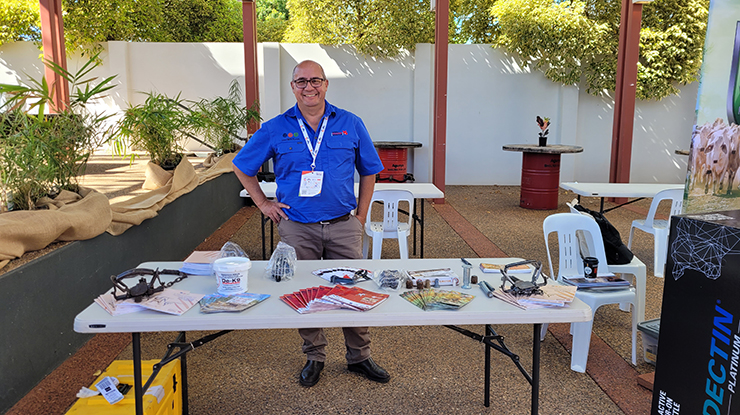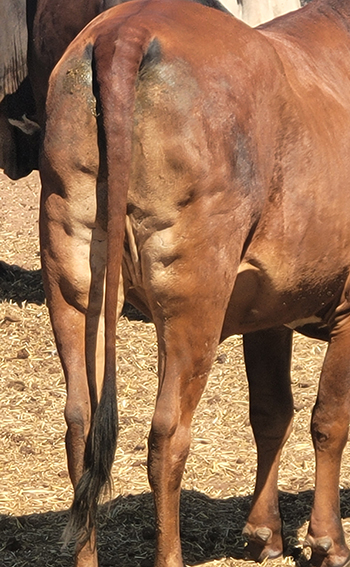 Greg Mifsud conducts regular training and awareness-raising activities in his role as National Wild Dog Management Coordinator at the Centre for Invasive Species Solutions.
Greg Mifsud conducts regular training and awareness-raising activities in his role as National Wild Dog Management Coordinator at the Centre for Invasive Species Solutions.
Working together key to tackling wild dogs
Wild dogs are an elusive and adaptable adversary to livestock productivity in many parts of Australia, but thanks to the perseverance and coordinated approach of well-connected groups of producers, gains are being made.
At last count, the economic impact of wild dogs was estimated to be $89–110 million/ year in lost agricultural productivity.
Greg Mifsud, the National Wild Dog Management Coordinator at the Centre for Invasive Species Solutions (CISS), suggests these losses could be even higher at today’s current market values.
Wild dogs are classed as pure dingoes (mainly found in northern Australia), wild domestic dogs, and those hybridised with dingoes (in southern Australia).
MLA supports CISS and its research into economically, ecologically and socially informed wild dog management processes and co-funds wild dog management coordinators around the country. Greater awareness and insights into how to best manage these ubiquitous pests have also been gained via MLA’s Producer Demonstration Site (PDS) projects.
Here, Greg explains how the increasingly collaborative approach to managing wild dogs is making solid progress.
Stronger together

Damage to heifer from dog bites
Greg said it’s important for producers to work together when facing the issue of wild dogs.
“It’s one thing to have access to all the best tools but quite another if you and your neighbour aren’t joining forces to implement a strategic approach – you don’t want to be chasing dogs from one property to another,” he said.
“These dogs have large home ranges and travel across those areas on a regular basis.
A coordinated program ensures dogs are exposed to control no matter where they happen to be, or whose property they are on, within that home range.”
Integrated management programs are essential – a targeted approach could include focusing on corridors between neighbouring properties to prevent recolonisation by wild dogs from nearby farms.
Adapting to change
Greg’s role at CISS centres around getting everyone on the same page.
“My job is to maintain engagement and support landholders to adopt best practice wild dog management techniques and develop management plans.
“Despite some very effective wild dog management and fencing programs, wild dogs are always in the landscape and continually pose a threat. Pest management is an adaptive approach – you need to review it all the time.”
Greg recommends producers develop syndicates or wild dog management groups to collectively develop management plans and look for options to support ongoing wild dog management that fit their landscape and production setting.
“Working collectively makes sense. Form a wild dog management group or, if you’re moving to a new area, ask around if there’s one you can join,” Greg said.
Building skills
Training is another aspect of his capacity-building work – this includes ensuring people know the best practice techniques, such as the correct way to lay baits or set traps, to achieve the best management outcomes.
Maintaining engagement and training is important to reflect staff turnover and changes in property ownership.
Best practice tools
Technology has improved producers’ ability to combine and enhance their data and helps inform where to best place control measures.
CISS’s WildDogScan and FeralScan apps allow producers to monitor and record wild dog sightings and share with their neighbours if they use the community function of the program.
(Information can be kept private at the user’s discretion but if you’re a member of a community group, the control data is automatically kept private.)
“On big cattle stations, staff see a lot of dogs and impacts while mustering – they all have smartphones, and can easily record data using the app while in the paddock.
“Sightings of wild dogs, mauled stock and where dogs have been shot or trapped can all be recorded in the app, and those records are automatically uploaded and displayed on the FeralScan webpage when they get back into service,” Greg said.
He said remote cameras were also effective – especially with their ability to send a text message when they sense movement – and could be placed at areas of known wild dog activity, such as water points. Keep watch Understanding wild dog behaviour will help finetune control measures, particularly around vulnerable periods such as lambing, calving and weaning.
“Protect your assets during these times, using small amounts of targeted control at strategic locations like water points, drainage lines, isolated areas of the property where wild dogs are likely to reside, or around paddocks where calving is likely to take place,” Greg said.
Tips for impact
- Optimise your risk management during calving/lambing.
- Wild dogs and foxes in the area during lambing can cause stress and mismothering.
- Protect young weaners who no longer have their mothers’ protection.
- Smaller weaners are most at risk.
- Sheep require year-round vigilance.
Mental health matters
Despite the significant psychological trauma producers face from ongoing wild dog attacks, Greg is pleased to witness a change in mood among those affected.
“We’re at a far better place than when I started this role in 2007. People better understand what to do and how to get support – 15 years ago there was a lot more angst than there is now,” Greg said.
|
Baiting and trapping tips 1. Community baiting is the most cost-effective approach to population-level control. 2. Dogs will commonly move along easier access routes such as vehicle tracks or fire breaks. 3. Put baits or control in areas where dogs will encounter them. 4. Intensively manage foxes to effectively target wild dogs as these inquisitive scavengers can undermine baits and traps and attack newborn lambs. 5. To protect working dogs, tether or tie 1080 baits (sodium monofluoroacetate) to a post or branch where possible, so they can’t be removed unless consumed. 6. Canid Pest Ejectors reduce the risk of 1080 being consumed by non-target animals as the trigger mechanisms prevent other animals from setting it off. Put traps near or under cover, not in the open. Lures will get wild dogs close enough to traps and out of the way of cattle and sheep. 7. Organic producers can access guidelines (scan the QR code) for compliant baiting programs. |



